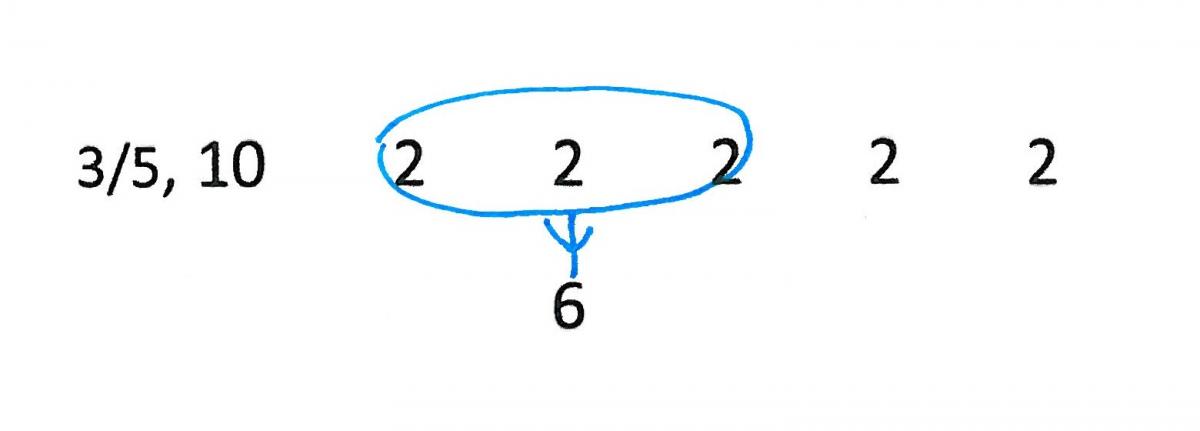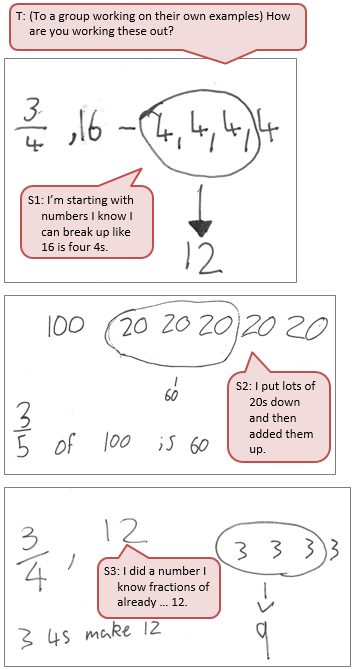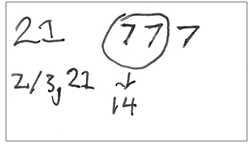The purpose of this activity is to engage students in using their number knowledge to understand and use an unfamiliar process.
This activity assumes the students have experience in the following areas:
- Knowing basic addition and subtraction facts.
- Partitioning and regrouping numbers to make calculation easier.
- Using fractions to represent parts of sets to the whole.
- Finding fractions of whole numbers.
The problem is sufficiently open ended to allow the students freedom of choice in their approach. It may be scaffolded with guidance that leads to a solution, and/or the students might be given the opportunity to solve the problem independently.
The example responses at the end of the resource give an indication of the kind of response to expect from students who approach the problem in particular ways.
A teacher showed her class an idea: 
and another example:

Can you make up one of your own?
The following prompts illustrate how this activity can be structured around the phases of the Mathematics Investigation Cycle.
Make sense
Introduce the problem. Allow students time to read it and discuss in pairs or small groups.
- Do I understand the situation? Explain how the examples were made?
- What might be good numbers to choose? Why?
- What are good fractions to use? Why?
- Are there any numbers and fractions that you should not use? Why?
Plan approach
Discuss ideas about how to solve the problem. Emphasise that, in the planning phase, you want students to say how they would solve the problem, not to actually solve it.
- What strategies will be useful to solve a problem like this?
- What maths will be handy to create my own examples?
- What fractions are good ones to get me started? Why are those fractions good?
- Can I make a list of numbers to try first? How will I choose my numbers?
- Do I need some tools to help me? Would a calculator or counters help?
Take action
Allow students time to work through their strategy and find a solution to the problem.
- Am I clear what my examples should look like?
- What is the same about the two examples the teacher gave us? What is different?
- Can I find example just with numbers or do I need counters or a diagram to help me?
- Are there some patterns I can use? What patterns will be useful?
- Have I checked my examples? Can I prove they are correct?
- Are my strategies the same as those others used?
- Could I try using another person’s strategy to see if it better than mine?
Convince yourself and others
Allow students time to check their answers and then either have them pair share with other groups or ask for volunteers to share their solution with the class.
- Have I got enough examples? How can I easily make more?
- Which strategies were most efficient?
- If I keep the number the same, can I make different examples with that number? How?
- If I start with a fraction, how can I choose numbers that will work well? How?
- Is there some maths that I need to solve problems like this? What is the maths? Where do I use that maths?
Examples of work
Work sample 1
The student chooses number that they know are easily broken into equal parts. They list the equal parts then express a collection of parts as a fraction.
Click on the image to enlarge it. Click again to close.
Work sample 2
The student begins with a number and uses division to break it into equal parts. From the number of parts they chose a fraction with the same denominator and work out the fraction of the whole number using multiplication.

